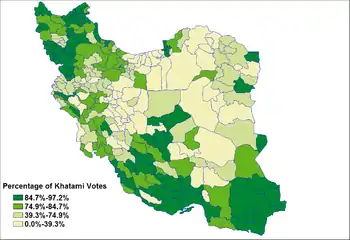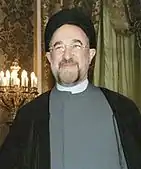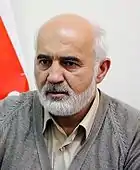2001 Iranian presidential election
Iranian presidential election of 2001 took place on 8 June 2001, and resulted in Mohammad Khatami being elected as the President of Iran for his second term.
| ||||||||||||||||||||
| Registered | 42,170,230[1] | |||||||||||||||||||
|---|---|---|---|---|---|---|---|---|---|---|---|---|---|---|---|---|---|---|---|---|
| Turnout | 66.77%[1] | |||||||||||||||||||
| ||||||||||||||||||||
 Percentage of votes that went to Mohammad Khatami per county | ||||||||||||||||||||
| ||||||||||||||||||||
Candidates
Although 814 candidates registered for the election,[1] including 25 women,[2] the Guardian Council reduced it to ten.
The final candidates were:[3][4]
- Mohammad Khatami, Incumbent President
- Ahmad Tavakkoli, Former Minister of Labour and Social Affairs
- Ali Shamkhani, Incumbent Minister of Defense
- Abdollah Jassbi, Incumbent Chancellor of Islamic Azad University
- Mahmoud Kashani, Former Iranian delegation to the International Court of Justice
- Hassan Ghafourifard, Former Minister of Energy and Member of Parliament
- Mansour Razavi, Incumbent Member of City Council of Tehran
- Shahabedin Sadr, Former Member of Parliament
- Ali Fallahian, Former Minister of Intelligence
- Mostafa Hashemi Taba, Incumbent Head of Physical Education Organization
Campaign
After the scandalous final two years of his term, Mohammad Khatami was expected to be elected by a much smaller margin than in 1997. His term was marred by the unlawful arrest of political activists, killings of Iranian dissidents, and closure of several Iranian newspapers. Though Khatami was still believed to win by a landslide, this oppression was thought to significantly impact his performance in the election.[5] Initially, Khatami had considered not running for reelection. But, after months of his supporters and party members pleading with him, he finally decided to declare his candidacy two months before the start of the election.[6] Central to Khatami's campaign were the issues of economic revival, job growth, and democratic reform. Khatami also sought to restore the austerity of the Iranian Revolution.[7] According to CNN, Khatami's aides described his campaign as a “referendum for reform”. [8] Most of Khatami's nine other challengers were independent conservatives, according to BBC. [9]
Results
| Candidate | Votes | % | |
|---|---|---|---|
| Mohammad Khatami | 21,656,476 | 76.90 | |
| Ahmad Tavakkoli | 4,387,112 | 15.58 | |
| Ali Shamkhani | 737,051 | 2.61 | |
| Abdollah Jassbi | 259,759 | 0.92 | |
| Mahmoud Kashani | 237,660 | 0.84 | |
| Hassan Ghafourifard | 129,155 | 0.45 | |
| Mansour Razavi | 114,616 | 0.40 | |
| Shahabedin Sadr | 60,546 | 0.21 | |
| Ali Fallahian | 55,225 | 0.19 | |
| Mostafa Hashemitaba | 27,949 | 0.09 | |
| Valid votes | 27,665,549 | 98.25 | |
| Blank or invalid votes | 493,740 | 1.75 | |
| Totals | 28,159,289 | 100.00% | |
| Sources: Sahliyeh[2] and RFE/RL[10] | |||
Turnout
| Province | Electorate | Actual Voters | Turnout |
|---|---|---|---|
| Ardabil | 806,656 | 467,859 | 58% |
| East Azerbaijan | 2,439,446 | 1,294,682 | 53.07% |
| West Azerbaijan | 1,726,987 | 974,181 | 56.41% |
| Bushehr | 512,382 | 365,099 | 71.26% |
| Esfahan | 2,852,882 | 1,735,814 | 60.84% |
| Fars | 2,676,431 | 1,821,626 | 68.06% |
| Gilan | 1,685,173 | 1,097,403 | 65.12% |
| Golestan | 964,042 | 725,934 | 75.3% |
| Hamadan | 1,179,237 | 743,372 | 63.04% |
| Hormozgan | 695,182 | 530,336 | 76.29% |
| Ilam | 325,224 | 250,759 | 77.1% |
| Kerman | 1,411,555 | 998,371 | 70.73% |
| Kermanshah | 1,243,128 | 790,685 | 63.6% |
| Khorasan | 4,129,936 | 3,124,814 | 75.66% |
| Khuzestan | 2,487,136 | 1,474,820 | 59.3% |
| Kohgiluyeh and Buyer Ahmad | 353,054 | 270,417 | 76.59% |
| Kurdistan | 910,364 | 486,596 | 53.45% |
| Lorestan | 1,080,763 | 702,936 | 65.04% |
| Markazi | 883,979 | 565,018 | 63.92% |
| Mazandaran | 1,900,246 | 1,302,654 | 68.55% |
| Qazvin | 670,614 | 500,917 | 74.7% |
| Qom | 555,944 | 428,005 | 76.99% |
| Semnan | 366,427 | 285,964 | 78.04% |
| Sistan and Baluchestan | 1,001,596 | 702,444 | 70.13% |
| Tehran | 7,643,471 | 5,202,274 | 68.06% |
| Yazd | 525,981 | 468,982 | 89.16% |
| Zanjan | 623,464 | 429,389 | 68.87% |
References
- "2001 Presidential Election", The Iran Social Science Data Portal, Princeton University, retrieved 10 August 2015
- Sahliyeh, Emile (2002). "The Reforming Elections in Iran, 2000–2001". Electoral Studies. Elsevier. 21 (3): 526–533. doi:10.1016/S0261-3794(01)00041-5.
- Muir, Jim (1 June 2001). "Iran election: People and policies". BBC. Retrieved 28 June 2013.
- "Iran's Presidential Candidates". The Associated Press. The Washington Post. 5 June 2001. Retrieved 25 January 2017.
- Esfandiari, Haleh (2002). An Assessment of the Iranian Presidential Elections. Woodrow Wilson International Center for Scholars. p. 1.
- Esfandiari, Haleh (2002). An Assessment of the Iranian Presidential Elections. Woodrow Wilson International Center for Scholars. p. 2.
- Esfandiari, Haleh (2002). An Assessment of the Iranian Presidential Elections. Woodrow Wilson International Center for Scholars. pp. 2, 3.
- "Presidential election in Iran".
- "Iran election: People and policies".
- Samii, Bill (11 June 2001). "Four More Years of What?". Iran Report. Free Europe/Radio Liberty. 4 (22).


